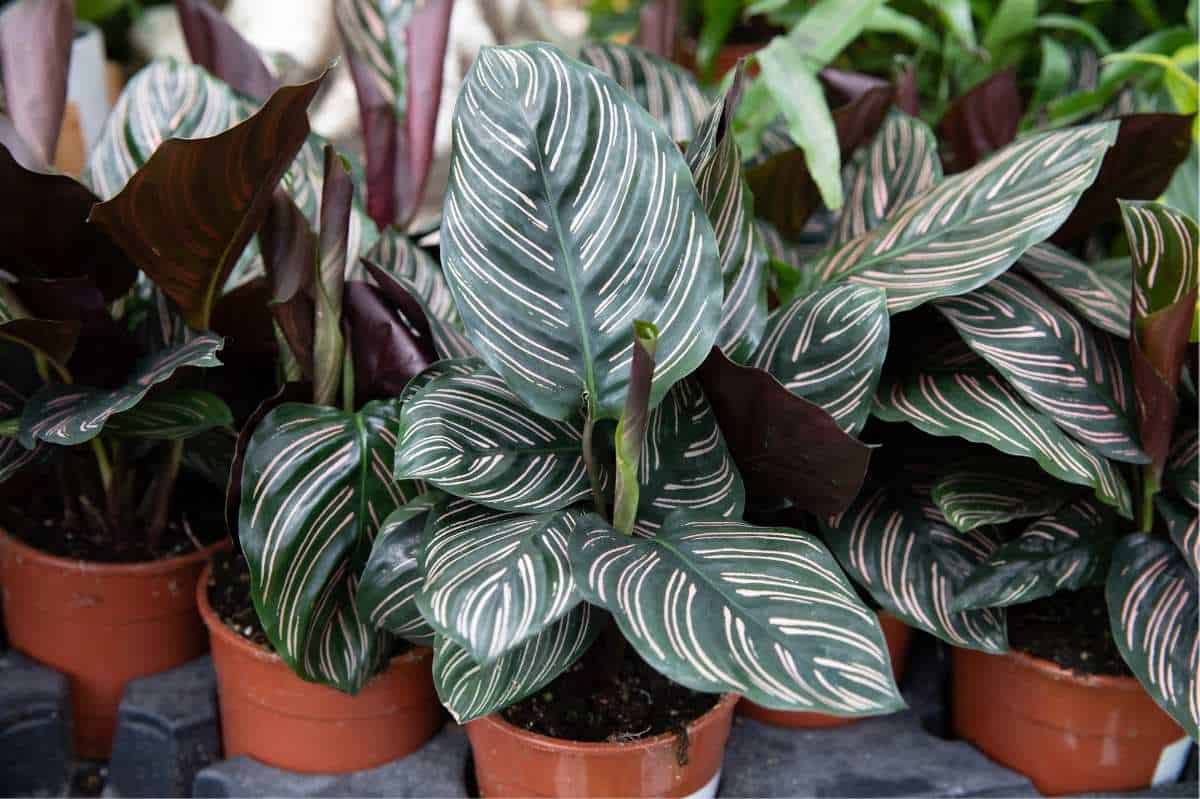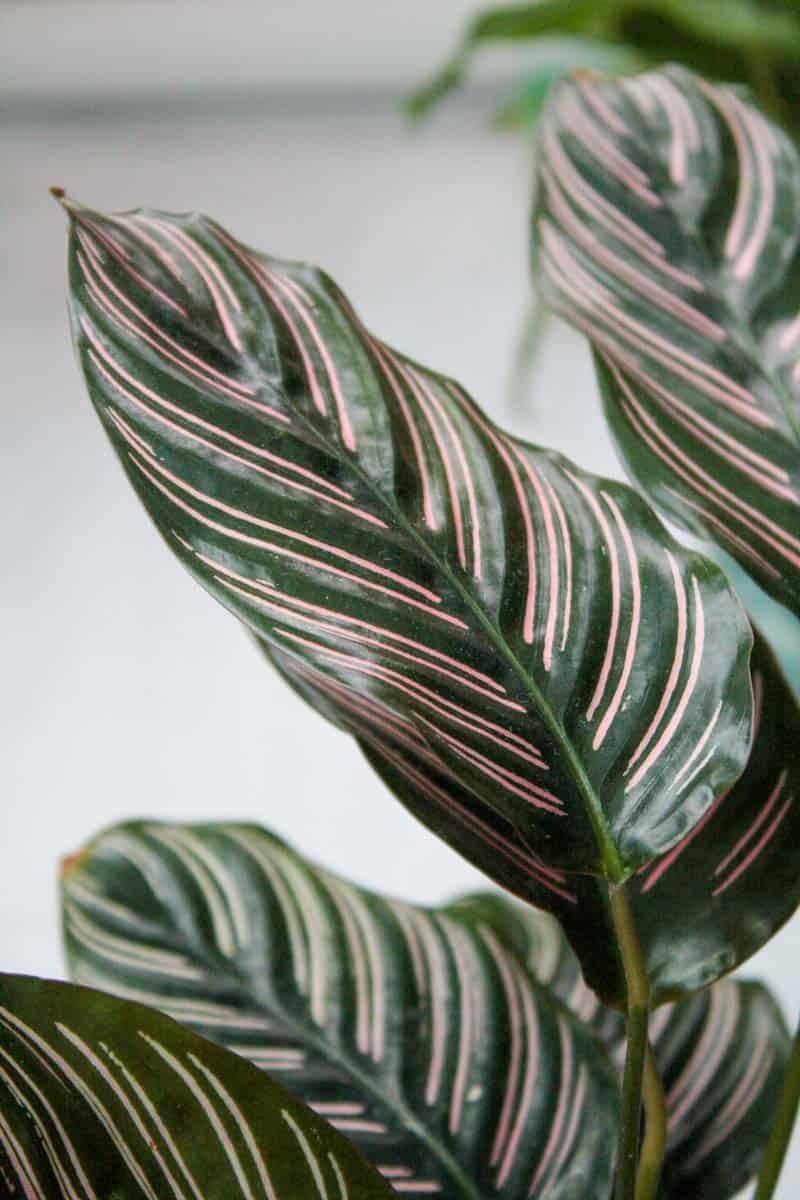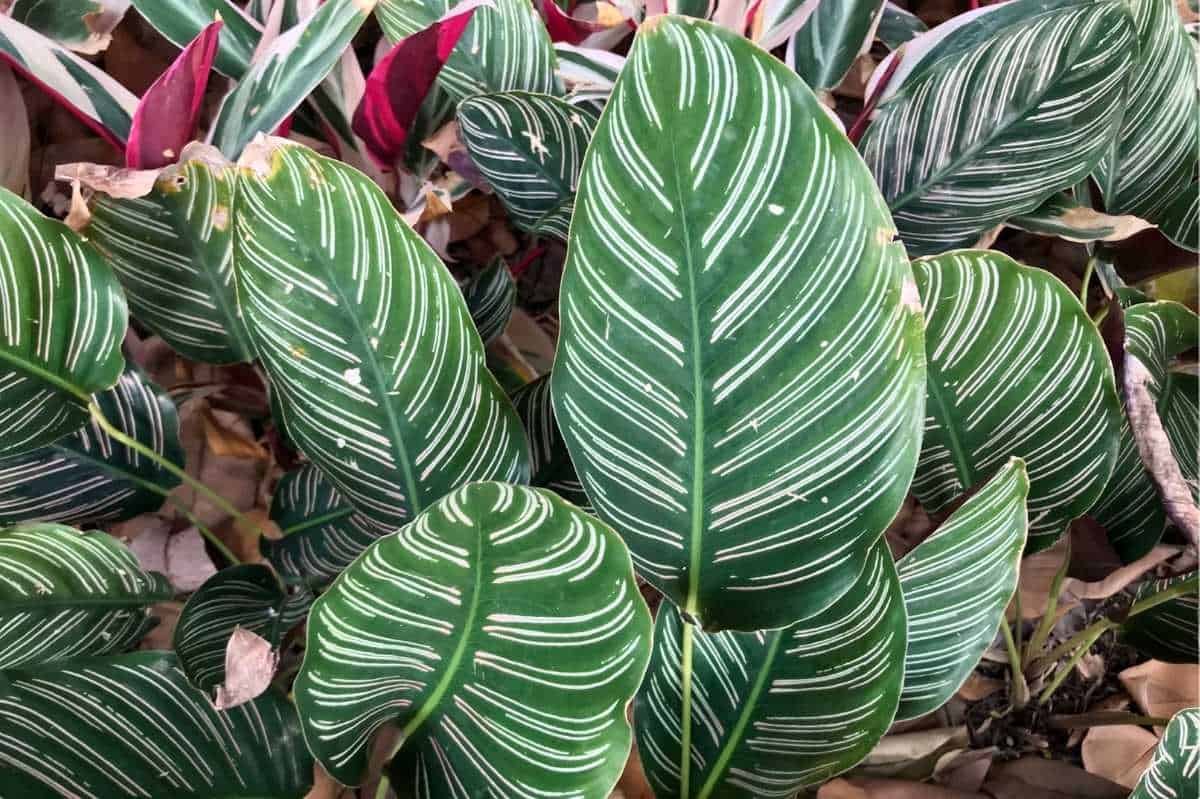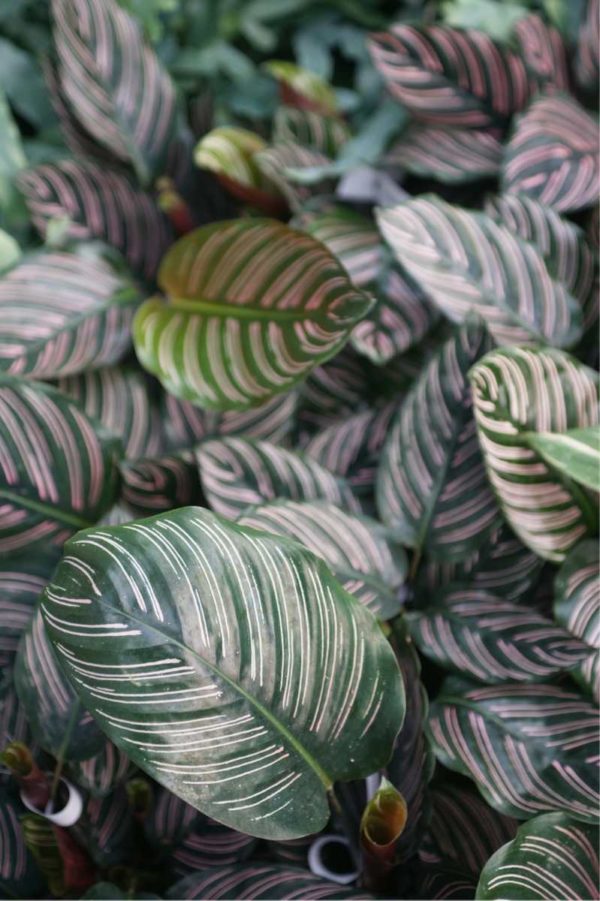A calathea ornata was one of my very first houseplants, and I’m not sure it will ever get replaced as my favorite. I always find myself drawn to plants with red or purple tones to them, and you just can’t beat a pink striped leaf. Let me tell you why a calathea ornata should be the next plant you bring home!

Table of Contents
What is calathea ornata?
As you’d expect from nearly any plant in the calathea genus, calathea ornata is known for its striking patterned leaves. Dark green leaves are dashed evenly with pale pink stripes, and each leaf grows gracefully from the end of its own long stem. Peek under a leaf, and you’ll find a beautiful maroon underside.
If you can’t find calathea ornata at your local nursery or favorite plant store, it may be going under a different name. You’ll often see these plants tagged as pinstripe calathea, or pin-stripe plant.
Why calathea ornata make great houseplants
The number one reason people love pinstripe calathea? Their visual impact. Its dark green leaves and pink stripes make a striking contrast, and the way the leaves arch from their stems looks so elegant. Plus, it is a plant that can thrive in a variety of lighting conditions (more on that in a minute), so it is easy to find a spot for a calathea ornata in most homes.
They are also one of the only houseplants you can get that actually move! Like other plants in the family marantaceae (prayer plants and other calathea), the pinstripe calathea closes up its leaves at night, and then unfolds them when the sun comes out.

Where to place calathea in your home
There are two things to consider when deciding where to place your calathea: light and humidity.
Light
Calathea ornata will thrive in medium amounts of indirect light—they do well near east or west facing windows, or south-facing windows where the light is filtered by trees or curtains. But they can also handle low light, better than some other calathea varieties.
Growfully Protip
If your calathea receives low amounts of light, it will likely need less frequent watering. Be sure you are checking the moisture of the soil before watering.
The one light your pinstripe plant can’t handle? Bright direct light. If the light is too bright, the lovely pink stripes will fade to white, and the leaves may burn. Stick with low to medium amounts of light with this one.
Humidity
While calathea ornata can be fairly flexible in the amount of light they receive, that’s not the case with their humidity levels. Natively rainforest plants of South America, they are used to very humid environments, and the air in our homes can’t always keep up.
If you notice dry, crispy leaf edges or curling leaves, your calathea ornata needs more humidity. There are a few simple ways to increase the humidity around your plant. Try placing your planter on a pebble tray, near a humidifier, or clustered with other plants.

How do I keep calathea ornata happy?
If you keep your pinstripe plant’s natural environment in mind, taking care of it won’t feel too complicated. In the rainforest, a calathea ornata experiences:
- Dappled sunlight, filtered down through the trees above them.
- High humidity.
- Consistently moist soil.
Now you just want to try to replicate those factors at home:
- Put your calathea somewhere it can receive at least some bright, indirect light daily. Remember, direct sunlight will bleach the color of the foliage and possibly burn it, so it is important that the light is filtered or reflected in some way before getting to your plant. Medium amounts of light are best, but calathea ornata can still do fine in low light.
Growfully Protip
Low light doesn’t mean no light! Make sure your calathea ornata is still seeing some sunlight every day.
- Give it that sweet, sweet humidity. Humidifiers, pebble trays, and grouping pots together are all great, simple ways to give calathea a humidity boost. We have more ideas in our full calathea care post.

- Give it enough water. Calathea like soil that is consistently moist, but not soggy. The frequency at which you’ll need to water depends on the amount of light your plant is getting—in lower light situations, you’ll likely need to water less often. A good rule of thumb is to water when the top inch or two of soil feels dry. Because of their preference for moist soil, calathea may do well with self-watering bulbs, too.
Growfully Protip
Just because calathea ornata likes moist soil, doesn’t mean it likes to be swamped. Be sure that your plant is in a container with drainage holes, and that you are waiting to water until the top inch of soil is dry. Otherwise, you’re headed towards root rot.
- Aerate the soil regularly. To ensure that moisture is being distributed evenly throughout the pot, it is a good idea to aerate the soil regularly. To do this, use a wooden chopstick to gently poke holes in the surface of the soil—this will let air and water get to all parts of the roots evenly.
- Use the right water. Calathea can be extremely picky about the quality of their water, and the pin-stripe calathea is no exception. Hard water, soft water, and fluoridated water (if you live in the United States, your tap water is probably fluoridated) can all make your calathea grumpy and browned. You’ll want to use distilled water, rain water, snow melt, or dechlorinated, filtered tap water.
Growfully Protip
Dechlorinating your water sounds like a pain, but all it means is that you let the filtered water sit on the counter for 24 hours in a clear container before using it to water your plants!
- When you see new growth, give it some fertilizer. When you see new leaves starting to pop up (they will look like tightly rolled scrolls), give your calathea some diluted houseplant fertilizer. Depending on how fast your plant is growing, you’ll want to reapply every 4-8 weeks.

- Give it some gentle mist (maybe). You can mist your pinstripe calathea with the same water you use for its regular watering on a daily basis, if you’d like. Does it boost the humidity? Meh, pretty minimally—you don’t want to rely on it as the only method for getting high humidity. But does it knock off pests like spider mites that are trying to infest your plant? Sure does! And is it a calming, satisfying way to connect with your plants? You bet.
Troubleshooting
Is your calathea struggling? Make sure you are meeting all its care needs, and then head on over to our calathea care guide for more troubleshooting advice.


Calathea Ornata (Pinstripe Calathea) Care Guide
Materials
- Calathea Ornata Plant
- Well-draining potting medium
Tools
- Container with a drainage hole
- Mister bottle (optional)
Instructions
 Avoid direct light. Direct sunlight will bleach the color from your pinstripe calathea, and may burn the leaves. Medium to low light are best.
Avoid direct light. Direct sunlight will bleach the color from your pinstripe calathea, and may burn the leaves. Medium to low light are best.- Water well. Calathea like consistently moist, but not soaking, soil. Water when the top inch of soil is dry.
- Use high quality water. Pinstripe calathea are very sensitive to the type of water they receive. Use distilled water, collected rainwater, or filtered tap water that has been left to sit on the counter for 24 hours to water your calathea ornata.
- Keep the humidity high. Group your plants together, use a pebble tray, or place your calathea near a humidifier to keep your plant happy.
- Mist often (optional). Misting won't necessarily take care of the humidity issue, but it will help to deter pests.
I can’t recommend a pinstripe calathea enough. Once you understand its care needs, you’ll find that it is a great plant!







